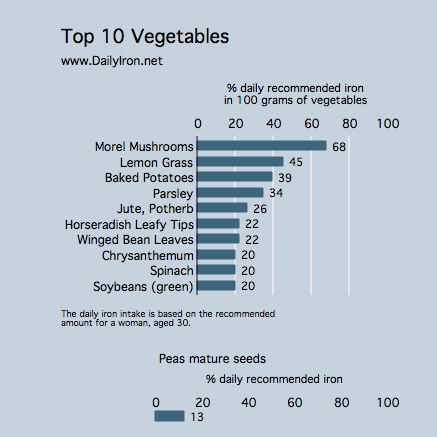Peas contain 2.2 milligrams of iron per 100 grams. Grams is a measure of weight. To put 100 grams in perspective, consider alternative measures for this food:
- 1 cup equals 120 grams.
In the category of vegetables, we included whole vegetable products in the Top 10 list. We excluded dried/dehydrated products from the Top 10. You will find some dehydrated vegetables high in iron per 100 grams,but they tend to be far more volume than anyone would consume. Furthermore, foods may be fortified with iron but are not included in this Top 10 list. The food tested for the particular graph below can be described more specifically as:
Peas, mature seeds, sprouted, raw
Read more about iron in vegetables or visit our iron-rich foods list.

Vegetables overall are not a great source of iron. Those vegetables that have a high content of iron also have the tendency to be packed with iron blockers — you may not absorb much of the iron from the vegetable itself.
Yet, even a vegetable with very little iron can play a key role in iron metabolism. Vegetables can be high in vitamin C and vitamin C can actually help you take up the iron better in non-meat food items; sprouted peas are a medium source of vitamin C.
As an example, you may wish to incorporate vine ripened tomatoes and green peppers with a grain-based entree or with a bean-based dish to increase your absorption of the iron in your entire meal. A fresh kiwi salad with your dinner would also improve your iron metabolism because of the fruit’s vitamin content. A glass of fruit juice is yet another an excellent approach.